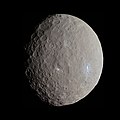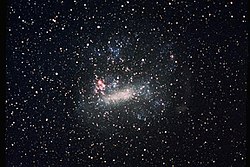An object with the spectral type L (also called L-dwarf) can be either a low-mass star, a brown dwarf or a young free-floating planetary-mass object. If...
35 KB (3,790 words) - 15:29, 26 June 2025
temperature, and brown dwarfs occupy types M (2100–3500 K), L (1300–2100 K), T (600–1300 K), and Y (< 600 K). As brown dwarfs do not undergo stable hydrogen...
167 KB (18,321 words) - 20:05, 25 June 2025
with a young age can also be a T-dwarf. T dwarfs are colder than L dwarfs, but warmer than Y dwarfs. The first T-dwarf discovered was Gliese 229B, which...
53 KB (5,535 words) - 19:56, 11 May 2025
Stellar classification (redirect from Class L star)
deviating mass have also been assigned letters: D for white dwarfs and L, T and Y for brown dwarfs (and exoplanets). In the MK system, a luminosity class is...
107 KB (11,666 words) - 14:52, 17 June 2025
dwarfs, mostly new. Hertzsprung–Russell diagram Spectral type O B A F G K M L T Brown dwarfs White dwarfs Red dwarfs Subdwarfs Main sequence ("dwarfs")...
154 KB (17,961 words) - 06:00, 27 June 2025
Nine likeliest dwarf planets and dates of discovery A dwarf planet is a small planetary-mass object that is in direct orbit around the Sun, massive enough...
100 KB (9,166 words) - 00:47, 24 June 2025
A red dwarf is the smallest kind of star on the main sequence. Red dwarfs are by far the most common type of fusing star in the Milky Way, at least in...
48 KB (5,552 words) - 00:37, 20 June 2025
massive (>5 MJ) and belong to the L- and T-dwarfs. There is however a small growing sample of cold and old Y-dwarfs that have estimated masses of 8-20...
89 KB (8,763 words) - 00:39, 20 June 2025
than T-dwarfs. Y-dwarfs have a similar spectrum when compared to the giant planet Jupiter. When the spectral classes of L dwarfs and T dwarfs were defined...
58 KB (5,877 words) - 11:46, 29 May 2025
Planetary-mass object (section Dwarf planets)
Wainscoat, R. J. (2017-03-01). "A Search for L/T Transition Dwarfs with Pan-STARRS1 and WISE. III. Young L Dwarf Discoveries and Proper Motion Catalogs in...
18 KB (2,000 words) - 12:22, 25 June 2025
Dwarf-tossing, also called midget-tossing, is a pub/bar attraction or activity in which people with dwarfism, wearing special padded clothing or Velcro...
20 KB (2,238 words) - 08:55, 22 June 2025
of notable brown dwarfs. These are objects that have masses between heavy gas giants and low-mass stars. The first isolated brown dwarf discovered was Teide...
38 KB (1,566 words) - 04:45, 9 May 2025
A dwarf galaxy is a small galaxy composed of about 1000 up to several billion stars, as compared to the Milky Way's 200–400 billion stars. The Large Magellanic...
25 KB (2,424 words) - 06:41, 17 May 2025
Kelu-1 (category L-type brown dwarfs)
free-floating later-than-M-type brown dwarfs discovered, and sometimes considered as prototype of L-type brown dwarfs. In 1987 María Teresa Ruiz decided...
25 KB (2,555 words) - 01:10, 19 April 2025
WISEP J190648.47+401106.8 (category L-type brown dwarfs)
is an L-type brown dwarf 54.7 light-years (16.8 parsecs) away in the constellation Lyra. It was discovered in 2011, and was the first L-dwarf discovered...
4 KB (358 words) - 06:03, 29 September 2024
2MASSW J0920122+351742 (category L-type brown dwarfs)
discovery, a paper by Ian Neill Reid et al. used Hubble WFPC2 to search binary L dwarfs and found that 2MASS J0902+3517 is extended in the F814W image, but not...
13 KB (1,168 words) - 17:37, 21 May 2025
SDSS J141624.08+134826.7 (category L-type brown dwarfs)
a nearby wide binary system of two brown dwarfs, located in constellation Boötes. The system consists of L-type component A and T-type component B. Component...
25 KB (1,604 words) - 22:12, 19 June 2025
2MASS J11151597+1937266 (category L-type brown dwarfs)
to search for faint moving stars. The spectral fit showed that it is an L dwarf, with low gravity. A spectral type of L2γ was assigned for 2MASS J1115+1937...
8 KB (827 words) - 08:12, 3 June 2025
Luhman 16 (category L-type brown dwarfs)
dwarf, the nearest L-type dwarf, and possibly the nearest T-type dwarf (if component B is of T-type). Luhman 16 is the nearest-known star/brown-dwarf...
46 KB (4,779 words) - 02:16, 20 June 2025
This is a list of the smallest known stars, brown dwarfs and stellar remnants, sorted by increasing size. The list is divided into sublists, and contain...
188 KB (11,967 words) - 01:11, 28 June 2025
WISEA 1810−1010 (category Brown dwarfs)
vapor. This was surprising because T-dwarfs are defined by methane in their atmosphere and the hotter L-dwarfs are partly defined by carbon monoxide...
12 KB (1,253 words) - 19:46, 11 May 2025
dwarf that orbits CFHTWIR-Oph 98 A, a M-type brown dwarf. The pair form a binary system. The primary is a M9–L1 dwarf and the secondary is an L dwarf...
4 KB (355 words) - 18:54, 19 November 2024
designation: 136199 Eris) is the most massive and second-largest known dwarf planet in the Solar System. It is a trans-Neptunian object (TNO) in the...
76 KB (6,463 words) - 20:54, 12 June 2025
A black dwarf is a theoretical stellar remnant, specifically a white dwarf that has cooled sufficiently to no longer emit significant heat or light. Because...
11 KB (1,329 words) - 01:51, 24 June 2025
Red Dwarf is a British science fiction comedy programme created by Rob Grant and Doug Naylor, consisting of a sitcom that aired on BBC Two between 1988...
148 KB (13,756 words) - 21:33, 22 June 2025
CWISE J1249+3621 (category L-type brown dwarfs)
constellation Canes Venatici. It has an L spectral type and is either a low-mass red dwarf or a high-mass brown dwarf. It has a speed of 456±27 km/s in the...
8 KB (757 words) - 20:36, 27 June 2025
researchers also detect hydrogen fluoride in the atmosphere. The object is an L-dwarf with a spectral type of L0. TYC 8998-760-1 c is a body with a mass of 7...
10 KB (837 words) - 21:14, 11 June 2025
Dwarfism is a condition of people and animals marked by unusually small size or short stature. In humans, it is sometimes defined as an adult height of...
43 KB (4,572 words) - 02:36, 26 May 2025
Insular dwarfism, a form of phyletic dwarfism, is the process and condition of large animals evolving or having a reduced body size when their population's...
52 KB (3,203 words) - 04:15, 2 June 2025
Sculptor Dwarf Galaxy, Fornax Dwarf Galaxy, Leo I (a dwarf galaxy), Leo II (a dwarf galaxy), Ursa Major I Dwarf Galaxy and Ursa Major II Dwarf Galaxy,...
51 KB (2,950 words) - 19:30, 12 June 2025





















